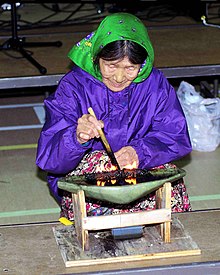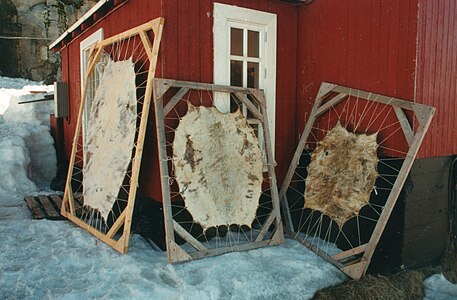Qulliq

The qulliq[1] or kudlik[2] (Inuktitut: ᖁᓪᓕᖅ, romanized: qulliq, IPA: [qulːiq]; Greenlandic: qulleq; Inupiaq: naniq), is the traditional oil lamp used by many circumpolar peoples, including the Inuit, the Chukchi[3] and the Yupik peoples.[4] The fuel is seal-oil or blubber, and the lamp is made of soapstone.[5] A qulliq is lit with a stick called a taqqut.
This characteristic type of oil lamp provided warmth and light in the harsh Arctic environment where there was no wood and where the sparse inhabitants relied almost entirely on seal oil or on whale blubber. This lamp was the single most important article of furniture for Inuit in their dwellings.[6]
History
[edit]It is uncertain in which period the seal-oil lamps began to be used. They are part of a series of technological innovations among the Arctic peoples whose introduction and spread has been partly documented. Oil lamps have been found in sites of Paleo-Eskimo communities dating back to the time of the Norton tradition, 3,000 years ago.[7] They were a common implement of the Dorset culture and of the Thule people, the lamps manufactured then showing little changes compared with more recent ones.[8]
In Inuit religion, the story the Sun and the Moon involves the Sun carrying a qulliq oil lamp.[9]
Among the Netsilik if the people breached certain taboos, Nuliajuk, the Sea Woman, held the marine mammal in the basin of her lamp. When this happened the angakkuq had to visit her to beg for game.[10] This story also inspired a New Year or Quviasukvik tradition in which three lamps were extinguished and relit during the first sunrise.
Historically, the lamp was a multi-purpose tool. The Arctic peoples used the lamp for illuminating and heating their tents, semi-subterranean houses and igloos, as well as for melting snow, cooking, and drying their clothes.
In present times such lamps are mainly used for ceremonial purposes. Owing to its cultural significance, a qulliq is featured on the coat of arms of Nunavut.
A qulliq was lit to commence the investiture ceremony of Mary Simon, the first Inuk, and indigenous person, to be appointed to the position of Governor General of Canada, in the Senate Chamber, 26 July 2021.[11]
Description and use
[edit]
The Inuit oil lamps were made mainly of soapstone, but there are also some made of a special kind of pottery.[12] Sizes and shapes of lamps could be different, but most were either elliptical or half-moon shaped.[13] The taqquti or wick trimmers, also known as lamp feeders, were made of wood, willow, soapstone, bone or ivory.[14]
The wick was mostly made of Arctic cottongrass (suputi), common cottongrass[15] and/or dried moss (ijju/maniq Inupiaq: peqaq)[12][16] It was lit along the edge of the lamp, providing a pleasant light.[17] A slab of seal blubber could be left to melt over the lamp feeding it with more fat.[18] These lamps had to be tended continually by trimming the wick in such a way that the lamp would not produce smoke.[19]
Although such lamps were usually filled with seal blubber and the English term 'seal-oil lamp' is common in writings about Arctic peoples, they could also be filled with whale blubber in communities where there was whaling.[20] However, the term 'whale oil lamp' refers to a different kind of lighting device.[21] Generally caribou fat was a poor choice, as was the fat of other land animals, seal oil being a more efficient fuel for the lamp. Women used to scrape the skin of a freshly skinned seal with an ulu in order not to waste any fat.[18][22] Once the seal skin was stretched and dried it would be scraped using a halukhit[23] to remove the dried fat.
Realizing that these lamps were such an important fixture of the Inuit household that "when the family moved the lamp went along with it", Arctic explorer William Edward Parry (1790–1855) commented:
The fire belonging to each family consists of a single lamp or shallow vessel of lapis ollaris, its form being the lesser segment of a circle. The wick, composed of dry moss rubbed between the hands until it is quite inflammable, is disposed along the edge of the lamp...[24]
Gallery
[edit]References
[edit]- ^ Ohokak, Gwen; Kadlun, Margo; Harnum, Betty (27 March 2014). Agulalik, Gwen (ed.). Inuinnaqtun to English Dictionary. Nunavut Arctic College. p. 81. Retrieved 7 August 2024.
- ^ "'The hardest part of being from a Northern Indigenous community is all the deaths'". 10 February 2019. Retrieved 8 January 2024.
- ^ "Edward J. Vajda, The Chukchi". Archived from the original on 21 June 2018. Retrieved 12 July 2016.
- ^ "National Museum of the American Indian : Yup'ik (Yupik Eskimo) Lamps". 2011. Archived from the original on 30 April 2011.
- ^ "PRISM - Blubber Lamps". Archived from the original on 24 October 2015. Retrieved 12 July 2016.
- ^ Joyce, T. A. & Dalton, O. M. (1910) Handbook to the ethnographical collections. British Museum. Dept. of British and Mediaeval Antiquities and Ethnography Joyce,
- ^ Dumond, Don E. (1975). "Coastal Adaptation and Cultural Change in Alaskan Eskimo Prehistory". In Fitzhugh, William (ed.). Prehistoric Maritime Adaptations of the Circumpolar Zone. The Hague: Mouton. p. 168. ISBN 0-202-33075-3.
- ^ "Far North Traditions". Archived from the original on 10 September 2004.
- ^ "eCUIP : The Digital Library : Science : Cultural Astronomy". ecuip.lib.uchicago.edu. Archived from the original on 22 September 2022. Retrieved 14 October 2023.
- ^ Rasmussen 1965:278
- ^ "Mary Simon officially becomes Canada's first Inuk Governor General". Archived from the original on 31 May 2022. Retrieved 26 July 2021.
- ^ a b "Alaska Native Collections - Oil lamp". Archived from the original on 18 March 2022. Retrieved 12 July 2016.
- ^ "The Inupiaq and the St. Lawrence Island Yupik Cultures of Alaska". 2011. Archived from the original on 5 February 2013.
- ^ Bennett, John; Rowley, Susan (19 May 2004). Uqalurait: An Oral History of Nunavut. McGill-Queen's Press. p. 302. ISBN 9780773570061. Retrieved 11 March 2020.
- ^ "Flora of the Canadian Arctic Archipelago". mun.ca/biology/delta/arcticf/. Archived from the original on 5 June 2011. Retrieved 31 March 2009.
- ^ "Fact Sheet: Information about the Qulliq" (PDF). Archived (PDF) from the original on 25 September 2020. Retrieved 11 March 2020.
- ^ "A woman demonstrates the use of a stone oil lamp, resting on a metal stand. Gambell, 1960. Anchorage Museum". Archived from the original on 26 February 2022. Retrieved 12 July 2016.
- ^ a b "Eskimos and the Long Winter Darkness". Archived from the original on 28 July 2012.
- ^ Peary, Josephine; Ahnighito, Marie (1903). Children of the Arctic. New York: F. A. Stokes Company. OCLC 6534622.
- ^ "Glossary Kudlik". Macdonald Stewart Art Centre. Archived from the original on 30 September 2003. Retrieved 31 March 2009.
- ^ "Antique Whale Oil Lamps - Demonstration". May 2014. Archived from the original on 10 May 2020. Retrieved 12 July 2016 – via www.youtube.com.
- ^ Kunuk, Zacharias (10 May 2019). Silakut Live From the Floe Edge Episode 3, Life at the Floe Edge. 8 minutes in. Archived from the original on 25 June 2022. Retrieved 12 May 2022.
- ^ "Ulukhaktok, Inuvialuit Settlement Region". 2021. Archived from the original on 22 May 2022. Retrieved 11 May 2022.
- ^ Kashevaroff, Andrew P. (1922) Descriptive booklet on the Alaska Historical Museum, Alaska Historical Library and Museum, b. 1863 Alaska Historical Association
Further reading
[edit]- Rasmussen, Knud (1926). Thulefahrt (in German). Frankfurt am Main: Frankurter Societăts-Druckerei.
- Rasmussen, Knud (1965). Thulei utazás. Világjárók (in Hungarian). transl. Detre Zsuzsa. Budapest: Gondolat. Hungarian translation of Rasmussen 1926.
- Rasmussen, Knud (1927) Across Arctic America: Narrative of the Fifth Thule Expedition
External links
[edit]- Qulliq (Oil Lamp) presented by Arnait Video Productions




